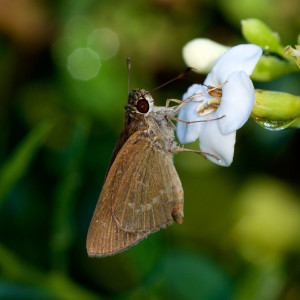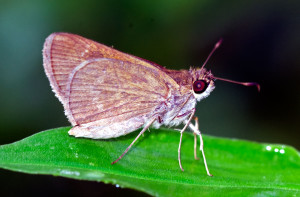Skippers are the little brown jobs of the butterfly world: small, fast, hard to see clearly, and hard to distinguish in the field. Fortunately, a good camera can overcome almost all of those problems, and it came in handy last month when I uncovered a new species visiting the yard: Three-spotted Skipper, Cymaenes tripunctus.

In the photo above, the butterfly is sipping nectar from the Bahama Strongbark (Bourreria succulenta) tree in the front yard. That tree is a favorite of many nectar-drinkers and pollinators, from the common European Honeybee to the more specialized leafcutter bees in the family Megachilidae. Flower flies, also called hover flies, in the family Syrphidae also frequent the blossoms, as do my most common resident butterflies, Zebra Longwing and Gulf Fritillary.
Last month I also noticed a huge spike in the population of Monk Skippers (Asbolis capucinus); on a good day I’d see 8 or 9 of them hanging out between the dwarf strongbark (I have a hedge of it out front) and the regular-sized tree. And one day I noticed another lightly marked brown butterfly, about half the size of the hulking Monk, and was able to get a couple of reasonable shots of it. Good enough, at least, to secure the ID.
Since that first sighting (September 23), these have been fairly regular visitors to the yard. Here’s another shot from a week later:

Now it’s near the middle of October, and I’m still seeing them on a regular basis (and still waiting for the light to be just right, so I can get a pretty, instead of just a decent, shot of one). But I can’t wait any longer to post the “New Backyard Bug” post or I’ll forget about it, as I’ve done with poor Pelidnota punctata, the grapevine beetle that I saw back in 2013 and have yet to finish writing up…
Like most butterflies in this family (the Grass Skippers), its larval host plant is various species of grasses. Listed in my manuals are bamboo, paragrass, crabgrass, thin paspalum, guineagrass, sugarcane, and eastern gamagrass. While I’d like to have that last species, which is nice and ornamental, I have thin paspalum (Paspalum setacea) instead. It’s a bunch grass, but very low growing, not very attractive, and I rip it out whenever it gets too thick.
I guess I’ll have to start inspecting it for caterpillars before I do!
